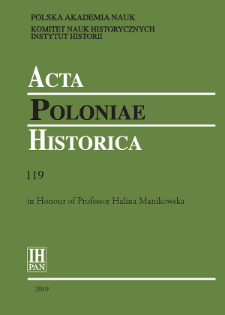- Wyszukaj w całym Repozytorium
- Piśmiennictwo i mapy
- Archeologia
- Baza Młynów
- Nauki przyrodnicze
Wyszukiwanie zaawansowane
Wyszukiwanie zaawansowane
Wyszukiwanie zaawansowane
Wyszukiwanie zaawansowane
Wyszukiwanie zaawansowane

Obiekt
Tytuł: Relics, Collections, and Memory
Inny tytuł:
Acta Poloniae Historica T. 119 (2019), In Honour of Professor Halina Manikowska
Współtwórca:
Hartzell, James : Red. ; Instytut Historii Polskiej Akademii Nauk ; Komitet Nauk Historycznych Polskiej Akademii Nauk
Wydawca:
Instytut Historii im. Tadeusza Manteuffla Polskiej Akademii Nauk
Miejsce wydania:
Opis:
Typ obiektu:
Abstrakt:
The article begins with an analysis of a modern relic and of relics in general. This leads to a twofold conclusion: we do not know of a society without relics; and the cult of relics is a cult of individuals, groups, or events these relics are believed to be related to. Relics therefore preserve the memories of those of whom they are relics. As such, they are tools of memorising, but not the only ones. Images, written texts, and recordings are also tools of memorising. Images and written texts belong to the class of objects called semiophors which contains all objects included in collections, the meaning of which depends upon the collection they are part of. It is therefore important to distinguish different types of collections: treasuries, private collections, museums (as well as libraries and archives), protected historical monuments, etc. The history of collections seen from this perspective appears to be tantamount to the history of the tools of memorisation, i.e. to the history of external memory preserved and contained in the objects. Recordings are not semiophors. They form a different class of objects because their meanings cannot be disclosed without special apparatuses which transform the physical traces left on them into images or sounds. Hence one may say they form a second belt of external memory, the first being formed by semiophors. The last and most recent belt is composed of all computers with their servers interconnected into the World Wide Web. This is a completely new type of tool of memorising, which duplicates all the previous ones and enables the user to retrieve an incomparably greater quantity of data, to do it much quicker, and to give virtual access to it to almost everybody.
Bibliografia:
Boutry Philippe, Pierre Antoine Fabre and Dominique Julia (eds.), Reliques modernes. Cultes et usages chrétiens des corps saints des Réformes aux révolutions (Paris, 2009), 2 vols.
Cordez Philippe, ‘Gestion et médiation des reliques au Moyen Âge. Le témoignage des authentiques et des inventaires’, in Jean-Luc Deuffic (ed.), PECIA. Ressources en médiévistique, viii-xi (2005), Reliques et sainteté dans l’espace médiéval (Saint-Denis, 2006), 33–63.
Pomian Krzysztof, ‘Les trésors : sacré, richesse et pouvoir’, in Lucas Burkart, Philippe Cordez, Pierre Alain Mariaux, and Yann Potin (eds.), Le trésor au Moyen Âge. Discours, pratiques et objets (Firenze, 2010), 131–60.
Pomian Krzysztof, ‘Sammlungen – eine historische Typologie’, in Andreas Grote (ed.), Macrocosmos in Microcosmo. Die Welt in der Stube 1450–1800. Berliner Schriften zur Museumskunde, x (Opladen, 1994), 107–26 (included in Krzysztof Pomian, Des saintes reliques à l’art moderne. Venise-Chicago: XIIIe–XXe siècle [Paris, 2003], 333).
Pomian Krzysztof, Collectionneurs, amateurs et curieux. Paris-Venise : XVIe–XVIIIe siècle (Paris, 1987).
Pomian Krzysztof, L’antropologia di fronte agli artefatti (Modena, 2013).
Czasopismo/Seria/cykl:
Tom:
Strona pocz.:
Strona końc.:
Szczegółowy typ zasobu:
Format:
Identyfikator zasobu:
oai:rcin.org.pl:81801 ; 0001-6829 ; 2450-8462 ; 10.12775/APH.2019.119.01
Źródło:
IH PAN, sygn. A.295/119 Podr. ; IH PAN, sygn. A.296/119 ; kliknij tutaj, żeby przejść
Język:
Prawa:
Licencja Creative Commons Uznanie autorstwa-Bez utworów zależnych 4.0
Zasady wykorzystania:
Zasób chroniony prawem autorskim. [CC BY-ND 4.0 Międzynarodowe] Korzystanie dozwolone zgodnie z licencją Creative Commons Uznanie autorstwa-Bez utworów zależnych 4.0, której pełne postanowienia dostępne są pod adresem: ; -
Digitalizacja:
Instytut Historii Polskiej Akademii Nauk
Lokalizacja oryginału:
Biblioteka Instytutu Historii PAN
Dofinansowane ze środków:
Narodowy Program Rozwoju Humanistyki
Dostęp:
Kolekcje, do których przypisany jest obiekt:
- Repozytorium Cyfrowe Instytutów Naukowych > Kolekcje Partnerów > Instytut Historii PAN > Czasopisma
- Repozytorium Cyfrowe Instytutów Naukowych > Kolekcje Partnerów > Instytut Historii PAN > Wydawnictwa Instytutu
- Repozytorium Cyfrowe Instytutów Naukowych > Kolekcje Partnerów > Instytut Historii PAN > Wydawnictwa Instytutu > Czasopisma
- Repozytorium Cyfrowe Instytutów Naukowych > Kolekcje Partnerów > Instytut Historii PAN > Wydawnictwa Instytutu > Czasopisma > Acta Poloniae Historica
- Repozytorium Cyfrowe Instytutów Naukowych > Piśmiennictwo > Czasopisma/Artykuły
Data ostatniej modyfikacji:
22 wrz 2023
Data dodania obiektu:
1 paź 2019
Liczba pobrań / odtworzeń:
197
Wszystkie dostępne wersje tego obiektu:
https://rcin.org.pl./publication/104466
Wyświetl opis w formacie RDF:
Wyświetl opis w formacie RDFa:
Wyświetl opis w formacie OAI-PMH:
| Nazwa wydania | Data |
|---|---|
| Pomian, Krzysztof (1934- ), Relics, Collections, and Memory | 22 wrz 2023 |
Obiekty Podobne
Pomian, Krzysztof (1934– )

 INSTYTUT ARCHEOLOGII I ETNOLOGII POLSKIEJ AKADEMII NAUK
INSTYTUT ARCHEOLOGII I ETNOLOGII POLSKIEJ AKADEMII NAUK
 INSTYTUT BADAŃ LITERACKICH POLSKIEJ AKADEMII NAUK
INSTYTUT BADAŃ LITERACKICH POLSKIEJ AKADEMII NAUK
 INSTYTUT BADAWCZY LEŚNICTWA
INSTYTUT BADAWCZY LEŚNICTWA
 INSTYTUT BIOLOGII DOŚWIADCZALNEJ IM. MARCELEGO NENCKIEGO POLSKIEJ AKADEMII NAUK
INSTYTUT BIOLOGII DOŚWIADCZALNEJ IM. MARCELEGO NENCKIEGO POLSKIEJ AKADEMII NAUK
 INSTYTUT BIOLOGII SSAKÓW POLSKIEJ AKADEMII NAUK
INSTYTUT BIOLOGII SSAKÓW POLSKIEJ AKADEMII NAUK
 INSTYTUT CHEMII FIZYCZNEJ PAN
INSTYTUT CHEMII FIZYCZNEJ PAN
 INSTYTUT CHEMII ORGANICZNEJ PAN
INSTYTUT CHEMII ORGANICZNEJ PAN
 INSTYTUT FILOZOFII I SOCJOLOGII PAN
INSTYTUT FILOZOFII I SOCJOLOGII PAN
 INSTYTUT GEOGRAFII I PRZESTRZENNEGO ZAGOSPODAROWANIA PAN
INSTYTUT GEOGRAFII I PRZESTRZENNEGO ZAGOSPODAROWANIA PAN
 INSTYTUT HISTORII im. TADEUSZA MANTEUFFLA POLSKIEJ AKADEMII NAUK
INSTYTUT HISTORII im. TADEUSZA MANTEUFFLA POLSKIEJ AKADEMII NAUK
 INSTYTUT JĘZYKA POLSKIEGO POLSKIEJ AKADEMII NAUK
INSTYTUT JĘZYKA POLSKIEGO POLSKIEJ AKADEMII NAUK
 INSTYTUT MATEMATYCZNY PAN
INSTYTUT MATEMATYCZNY PAN
 INSTYTUT MEDYCYNY DOŚWIADCZALNEJ I KLINICZNEJ IM.MIROSŁAWA MOSSAKOWSKIEGO POLSKIEJ AKADEMII NAUK
INSTYTUT MEDYCYNY DOŚWIADCZALNEJ I KLINICZNEJ IM.MIROSŁAWA MOSSAKOWSKIEGO POLSKIEJ AKADEMII NAUK
 INSTYTUT PODSTAWOWYCH PROBLEMÓW TECHNIKI PAN
INSTYTUT PODSTAWOWYCH PROBLEMÓW TECHNIKI PAN
 INSTYTUT SLAWISTYKI PAN
INSTYTUT SLAWISTYKI PAN
 SIEĆ BADAWCZA ŁUKASIEWICZ - INSTYTUT TECHNOLOGII MATERIAŁÓW ELEKTRONICZNYCH
SIEĆ BADAWCZA ŁUKASIEWICZ - INSTYTUT TECHNOLOGII MATERIAŁÓW ELEKTRONICZNYCH
 MUZEUM I INSTYTUT ZOOLOGII POLSKIEJ AKADEMII NAUK
MUZEUM I INSTYTUT ZOOLOGII POLSKIEJ AKADEMII NAUK
 INSTYTUT BADAŃ SYSTEMOWYCH PAN
INSTYTUT BADAŃ SYSTEMOWYCH PAN
 INSTYTUT BOTANIKI IM. WŁADYSŁAWA SZAFERA POLSKIEJ AKADEMII NAUK
INSTYTUT BOTANIKI IM. WŁADYSŁAWA SZAFERA POLSKIEJ AKADEMII NAUK


































